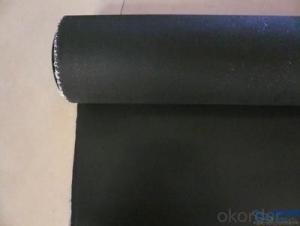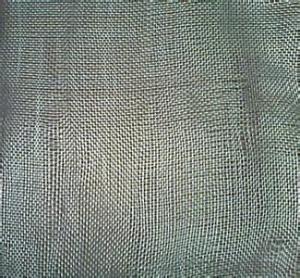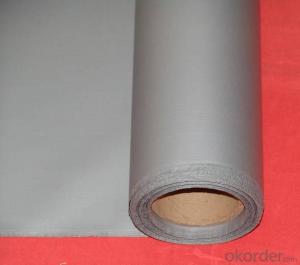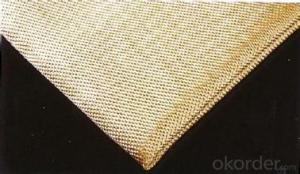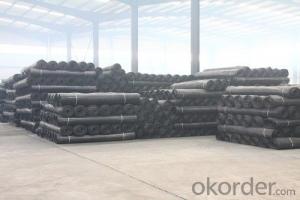E-glass Fiber High Silica Cloth
- Loading Port:
- China Main Port
- Payment Terms:
- TT OR LC
- Min Order Qty:
- -
- Supply Capability:
- -
OKorder Service Pledge
Quality Product, Order Online Tracking, Timely Delivery
OKorder Financial Service
Credit Rating, Credit Services, Credit Purchasing
You Might Also Like
Quick Details
| Place of Origin: | Model Number: | Weight: | |||
| Width: | Length: | Thickness: | |||
| Density: | Use: | Style: | |||
| Feature: | Supply Type: | Yarn Count: | |||
| Material: |
Packaging & Delivery
| Packaging Detail: | we packed 100m as one roll, one roll packed with box |
| Delivery Detail: | 3 days after get the deposit |
Specifications
high silica fiber
1,300-1200g/m2
2,plain & Twill Woven
3,E-Glass
4,1000-2000mm
- Q:Can fiberglass fabric be used for indoor applications?
- Yes, fiberglass fabric can be used for indoor applications. It is commonly utilized for insulation, soundproofing, and reinforcement purposes in various indoor settings such as homes, offices, and commercial buildings.
- Q:What are the different fabric coatings available for fiberglass fabric?
- Fiberglass fabric can be coated with various materials, each offering unique properties and advantages. The options for fabric coatings include: 1. Silicone Coating: When it comes to heat protection, silicone coatings are unbeatable. They can withstand high temperatures and are commonly used in applications like insulation blankets or protective covers for machinery. Silicone-coated fiberglass fabric also has good chemical resistance, making it suitable for environments with exposure to oils, solvents, and corrosive substances. 2. Polyurethane Coating: A polyurethane coating provides flexibility and durability, enhancing the fabric's performance and lifespan. It is highly resistant to abrasion, water, and chemicals, making it suitable for applications such as flexible ducting, conveyor belts, and protective clothing. 3. PTFE (Polytetrafluoroethylene) Coating: PTFE coatings, also known as Teflon coatings, are renowned for their non-stick properties. This coating allows for easy release, making it ideal for conveyor belts, release sheets, and non-stick surfaces for heat sealing and packaging equipment. 4. Acrylic Coating: Acrylic coatings offer excellent resistance to UV radiation, weathering, and mildew. They are commonly used in outdoor applications like awnings, canopies, and furniture coverings. Acrylic-coated fiberglass fabric also provides a smooth surface finish, making it popular for signage and advertising displays. 5. Neoprene Coating: Neoprene coatings are highly resistant to oil, chemicals, and moderate temperatures. They are often used in applications that require protection against abrasion, such as flexible connectors, expansion joints, and gaskets. These examples highlight the diverse range of fabric coatings available for fiberglass fabric. The choice of coating depends on specific requirements, such as temperature resistance, chemical resistance, flexibility, and durability. Seeking advice from a fabric specialist or manufacturer can help determine the most suitable coating for a particular application.
- Q:What are the advantages of using fiberglass fabric in construction?
- Fiberglass fabric offers numerous benefits for construction purposes. Firstly, it boasts exceptional strength and durability, with a high tensile strength that enables it to withstand substantial forces without breaking or tearing. This makes it ideal for reinforcing structures and providing added strength to various construction elements. Secondly, fiberglass fabric is lightweight in comparison to materials like steel or concrete. This lightness makes it easier to handle and transport, resulting in increased efficiency and reduced labor costs during the construction process. Moreover, fiberglass fabric exhibits impressive resistance to corrosion. Unlike metals, which are prone to rust over time, fiberglass fabric remains unaffected, making it a long-lasting and low-maintenance option for construction projects. Its resistance to corrosion also enables its use in various environments, including those with high moisture or chemical levels. Additionally, fiberglass fabric is a non-conductive material, making it perfect for applications where electrical insulation is necessary, such as electrical panels or wiring systems. It provides a safe and reliable solution for preventing electrical currents from passing through and causing potential hazards. Another advantage of using fiberglass fabric in construction lies in its versatility. It can be molded and shaped into various forms, allowing for customization and flexibility in design. This versatility empowers architects and builders to create unique structures and achieve specific aesthetic goals. Lastly, fiberglass fabric is fire-resistant. It possesses a high melting point and does not support combustion, making it a safer option in terms of fire protection. By incorporating fiberglass fabric into construction projects, the risk of fire spreading and causing extensive damage can be significantly reduced. In conclusion, the benefits of using fiberglass fabric in construction include its strength, lightweight nature, corrosion resistance, electrical insulation properties, versatility, and fire-resistant qualities. These advantages make it a reliable and efficient material choice for a wide range of construction applications.
- Q:How does fiberglass fabric perform in water repellency?
- Fiberglass fabric exhibits exceptional water repellency due to its composition of woven glass fibers, which possess a natural hydrophobic quality. This inherent characteristic prevents water molecules from easily permeating the fabric, resulting in a high level of resistance to water absorption. The hydrophobic nature of fiberglass fabric makes it an ideal choice for applications where water repellency is essential, such as the manufacturing of outdoor apparel, tents, and boat covers. Even when exposed to water, the fabric remains relatively dry, avoiding any increase in weight or water saturation. Furthermore, the construction of fiberglass fabric enables it to maintain its water repellency over an extended period. The fabric does not readily lose its hydrophobic properties, even with repeated exposure to water or washing. This durability makes fiberglass fabric a reliable option for situations requiring long-term water resistance. It is worth noting, however, that while fiberglass fabric exhibits a high resistance to water absorption, it is not entirely waterproof. Under extreme circumstances like heavy rainfall or prolonged submersion, some water may eventually seep through the fabric. Nevertheless, fiberglass fabric surpasses many other materials in terms of water repellency, making it a favored choice across various industries.
- Q:Can fiberglass fabrics be used for outdoor applications?
- Yes, fiberglass fabrics can be used for outdoor applications. Fiberglass is known for its durability and resistance to harsh weather conditions, making it an ideal material for outdoor use. It is commonly used in outdoor furniture, awnings, canopies, and covers. Fiberglass fabrics are also resistant to UV rays, moisture, and mildew, allowing them to maintain their strength and appearance even when exposed to the elements. Additionally, fiberglass fabrics are lightweight and flexible, making them easy to install and work with for outdoor projects.
- Q:Can fiberglass fabric be used as a heat shield?
- Yes, fiberglass fabric can be used as a heat shield due to its high resistance to heat and flame. It is commonly utilized in various industries, including aerospace and automotive, to protect against heat and thermal radiation.
- Q:What are the different thicknesses available for fiberglass fabric?
- Different applications and requirements can be accommodated by fiberglass fabric, which is available in a variety of thicknesses. The most common thicknesses range from 0.5 osy to 3.0 osy. However, it is important to note that fiberglass fabric is measured in weight per square yard, not physical thickness. For lightweight and flexible fabric needs, the thinnest options, such as 0.5 osy, are commonly used. These fabrics find applications in industries like aerospace, automotive, and marine, where weight reduction and flexibility are crucial factors. On the other hand, thicker options ranging from 1.5 osy to 3.0 osy are typically chosen for applications that require higher strength and durability. These fabrics are commonly used in industries like construction, insulation, and industrial manufacturing, where a stronger and more rigid material is necessary. It is worth mentioning that fiberglass fabric can be customized to meet specific thickness requirements. Manufacturers have the ability to tailor the fabric's weight per square yard to match the desired specifications of a particular project. In summary, fiberglass fabric offers a range of thickness options, from 0.5 osy to 3.0 osy, to fulfill the diverse needs of different applications. The appropriate thickness selection depends on factors such as desired strength, flexibility, weight reduction, and durability required for the specific project or industry.
- Q:Is fiberglass fabric resistant to chemicals in water treatment facilities?
- Yes, fiberglass fabric is generally resistant to chemicals in water treatment facilities. Fiberglass is known for its excellent chemical resistance, meaning it can withstand exposure to various chemicals without deteriorating or losing its structural integrity. This makes it an ideal material for use in water treatment facilities, where chemicals are used for disinfection, pH adjustment, and other treatment processes. Fiberglass fabric can resist the corrosive effects of chlorine, acids, alkalis, and other chemicals commonly found in water treatment facilities. Additionally, fiberglass is non-reactive, meaning it does not interact with or contaminate the water being treated. This makes it a reliable and durable choice for use in water treatment applications.
- Q:Does the construction of insulation alkali resistant glass fiber cloth need fixing with thermal insulation nail?
- 1. location: insulation board affixed to the wall, to determine the anchor point position;2. drilling: through the already placed insulation board, according to the prescribed size of drilling (Note: the actual depth of the wall should be more than 7CM);3. meshing: the insulation nail through the body heat insulation plate, so that the insulation nail four ribs in the heat transfer disc;4. implantation: insert the nail tube directly into the drilled nail hole to the heat preservation plate and stick it on the heat insulation board;5. type: matching plastic nail hammer type nail tube (plastic nail should be parallel with the insulation plate.).
- Q:Is fiberglass fabric resistant to UV degradation in outdoor applications?
- Yes, fiberglass fabric is highly resistant to UV degradation in outdoor applications. Fiberglass fabric is made from fibers that are manufactured to withstand prolonged exposure to sunlight and other environmental factors. The fabric is treated with special coatings or finishes that provide additional protection against UV radiation. This UV resistance makes fiberglass fabric an ideal choice for outdoor applications where exposure to sunlight is a concern, such as in awnings, canopies, and outdoor furniture. Additionally, fiberglass fabric maintains its strength and integrity even after years of exposure to UV rays, ensuring its long-lasting performance in outdoor settings.
1. Manufacturer Overview |
|
|---|---|
| Location | |
| Year Established | |
| Annual Output Value | |
| Main Markets | |
| Company Certifications | |
2. Manufacturer Certificates |
|
|---|---|
| a) Certification Name | |
| Range | |
| Reference | |
| Validity Period | |
3. Manufacturer Capability |
|
|---|---|
| a)Trade Capacity | |
| Nearest Port | |
| Export Percentage | |
| No.of Employees in Trade Department | |
| Language Spoken: | |
| b)Factory Information | |
| Factory Size: | |
| No. of Production Lines | |
| Contract Manufacturing | |
| Product Price Range | |
Send your message to us
E-glass Fiber High Silica Cloth
- Loading Port:
- China Main Port
- Payment Terms:
- TT OR LC
- Min Order Qty:
- -
- Supply Capability:
- -
OKorder Service Pledge
Quality Product, Order Online Tracking, Timely Delivery
OKorder Financial Service
Credit Rating, Credit Services, Credit Purchasing
Similar products
New products
Hot products
Hot Searches
Related keywords
